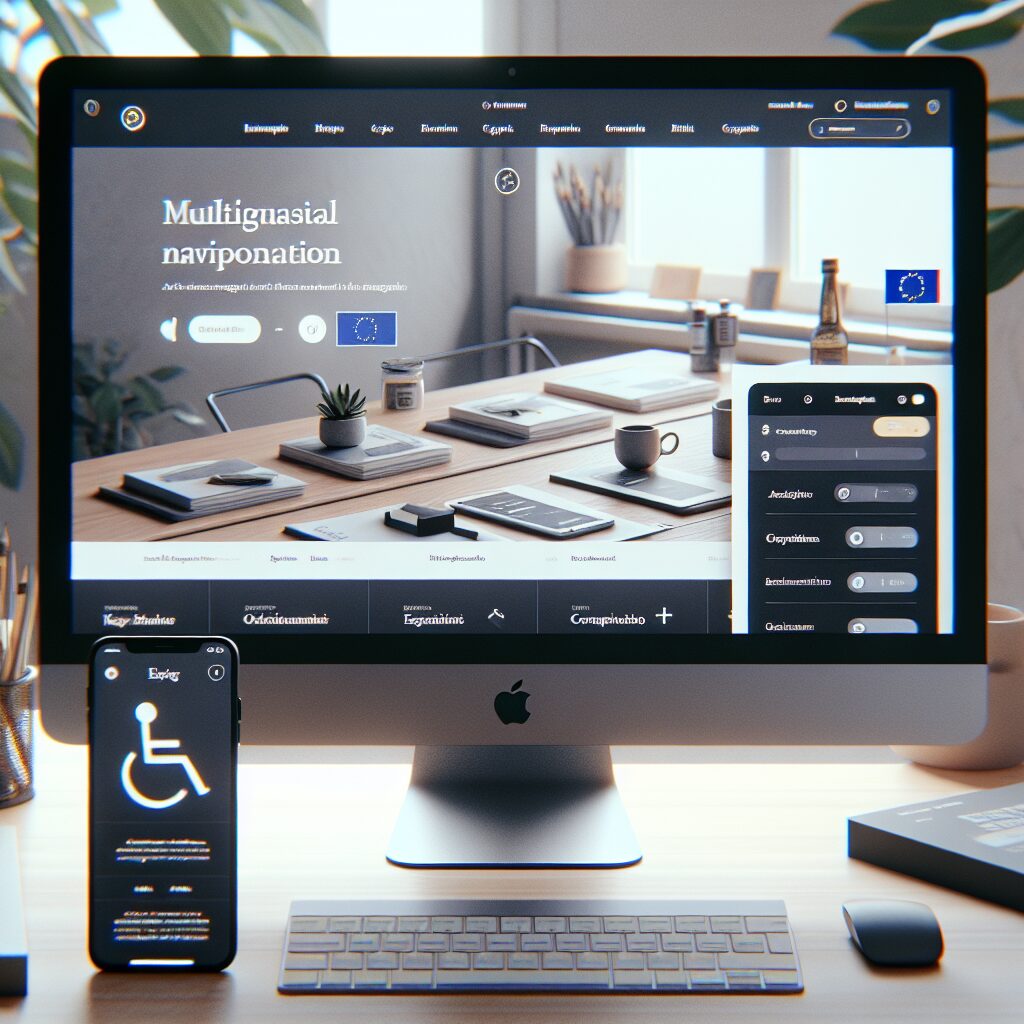About eldris
Clone.Eldris.ai empowers brands to instantly replicate and translate their websites for seamless global expansion. Our automated system delivers SEO-friendly, multilingual clones that launch in days, not months.
In This Article
- The EU Accessibility Act becomes enforceable on 28 June 2025 for all digital services.
- Full EU accessibility compliance is a legal necessity, not simply a best practice.
- EN 301 549 outlines the technical standards your website must meet.
- Accessibility must include multilingual design tailored for European audiences.
- Automated tools should be paired with manual audits and user testing.
- Use development workflows that prioritise inclusive design from ideation through to publication.
- Non-compliance poses serious financial, legal, and reputational risks.
- A future-proofed online store is both accessible and competitive.
Understanding the EU Accessibility Act
What Is the EU Accessibility Act and Who Must Comply?
The European Accessibility Act (EAA), established in 2019, is a landmark legislative directive aimed at improving the daily lives of people with disabilities. It sets minimum accessibility requirements for a range of products and services, including digital platforms. Central to this initiative is the principle that all individuals, regardless of ability, must have equal access to digital and physical environments. For online retailers, this means ensuring their websites, mobile apps, and digital communications adequately support users with different abilities. Failure to meet EU accessibility compliance can result in significant fines, legal repercussions, and reputational damage.

2025 EU Accessibility Requirements Explained
What Online Stores Need to Do by June 2025
By 28 June 2025, all online businesses operating within the European Union must achieve full conformity with the EAA. While microenterprises are largely exempt, SMEs and larger organisations must implement accessible design in all digital services. Requirements include, but are not limited to, screen-reader compatibility, keyboard navigation, resizable text, alternative text for images, consistent structure, and multilingual accessibility. Furthermore, eCommerce transactions must be operable through assistive technologies, and documentation (such as invoices and service contracts) must also meet accessible format standards. Non-compliance not only poses legal risks but can alienate a significant segment of the market. Therefore, planning for EU accessibility compliance now is essential.
“Accessibility is not an add-on – it’s a legal obligation and a competitive advantage in the modern EU digital market.”
Key Design Principles for Accessibility
To meet EU accessibility compliance, adhering to foundational design principles is critical. Start by integrating the POUR principles of accessibility: Perceivable, Operable, Understandable, and Robust. Perceivable design ensures that users can access information through various sensory modalities (e.g., visual, auditory, tactile). Operable websites allow navigation via keyboard only, without relying solely on mouse inputs. Understandable interfaces present information clearly, avoiding overly complex language, and ensuring predictable user interactions. Lastly, robustness ensures that the platform is compatible with a broad array of assistive technologies, both current and future-facing. Designing with these principles in mind from the outset of any digital project vastly reduces retrofitting costs and promotes a user-centred experience.
EN 301 549: The Standard Every Site Must Meet
The EN 301 549 standard is the European Union’s harmonised benchmark for accessibility in ICT (Information and Communication Technology), closely aligned with WCAG 2.1 Level AA. Businesses aiming to reach EU accessibility compliance must adhere to EN 301 549 in all digital offerings. This standard outlines specific requirements covering functionality such as multimedia captioning, accessible PDF documentation, navigation consistency, text-to-speech support, and form labelling. Importantly, EN 301 549 is not just a checklist—it’s a dynamic framework that evolves in line with technological advances. Regularly reviewing this standard ensures your organisation remains up-to-date and legally compliant. Training your development team on EN 301 549 is a proactive measure that prevents costly oversights.
Compliant Tools That Accelerate Your Work
Meeting accessibility requirements doesn’t mean starting from scratch. Several established tools can streamline your journey toward EU accessibility compliance. Notable solutions include the WAVE Accessibility Evaluation Tool and axe DevTools, which assess website components against accessibility standards. Additionally, content management systems like WordPress and platforms like Shopify now offer built-in accessibility plugins to automate compliance checkpoints. Leveraging AI-powered platforms that flag or even fix accessibility errors in real-time can save valuable development hours. Integrating automated testing tools into your DevOps pipeline ensures ongoing conformity, rather than relying on sporadic audits. It’s also worthwhile to invest in screen reader simulators and voice command emulators to emulate real-user experiences. Use these tools not just at the final stage, but throughout content creation and development to catch issues early.
Multilingual Accessibility for European Markets
The EU is home to 24 official languages and a multitude of regional dialects. Therefore, EU accessibility compliance demands more than literal translation; it requires full localisation of content and interaction flows. Accessible websites must offer consistent support in multiple languages without sacrificing clarity or navigational logic. For example, screen-reader compatibility must remain functional in all supported languages, and form input errors must display with context-relevant prompts. Furthermore, visual translations such as sign language videos should match the linguistic norms of each target region. Failing to implement multilingual accessibility risks isolating users not only due to physical limitations but also linguistic ones. Consider partnering with localisation experts who understand linguistic accessibility nuances or using AI-assisted localisation tools tested for multilingual performance. Learn more about Ecommerce Localisation and Regulatory Compliance Strategies
Common Compliance Mistakes and How to Avoid Them
One frequent mistake is assuming that visual tweaks alone—such as increasing font size or changing colour contrast—are sufficient for EU accessibility compliance. While these are important, true compliance goes beyond surface adjustments. Another common pitfall is relying heavily on automated testing tools without following up with manual evaluation by accessibility experts. Additionally, neglecting mobile accessibility is becoming increasingly costly. With growing numbers of consumers shopping via mobile devices, your web platform must be fully responsive and support dynamic text resizing and voice commands. Also, avoid using CAPTCHA fields that are not screen-reader friendly or lack audio alternatives. Be proactive by conducting periodic audits and engaging diverse user groups with disabilities for feedback. This holistic approach reduces shutdown risks due to non-compliance and enhances user trust. Read a related article
Risk Mitigation: Legal, Financial, and Reputational
The costs of non-compliance are more than theoretical. Under the EAA, national enforcement agencies will have the authority to inspect and penalise non-compliant digital services. Legal risks include injunctions, fines, and even forced product withdrawal. Financially, retrofitting digital assets post-launch can be exponentially more expensive than building them accessibly from the beginning. Furthermore, reputational risks are increasingly critical in today’s socially conscious marketplace. Consumers are holding brands accountable for their inclusivity commitments. When users encounter barriers, they not only abandon purchases – they also share negative experiences that can go viral. Taking EU accessibility compliance seriously now helps brands demonstrate accountability, reduce legal exposure, and improve overall customer satisfaction. Official EU guidance on web accessibility rules
Auditing and Monitoring Tools for Long-Term Compliance
Maintaining compliance is an ongoing process. Auditing and monitoring tools provide a structured way to track your site’s accessibility over time. Solutions like Siteimprove, Monsido, and Silktide offer dashboards that aggregate accessibility insights and suggest clear remediation paths. Automated monitoring tools should be scheduled to scan weekly, catching regressions quickly as content and features evolve. It’s also important to schedule manual audits at least quarterly. Automated tests often miss contextual and judgement-based failures, such as poor link descriptions or unclear form instructions. Pairing automated scans with usability testing from individuals with disabilities provides the most comprehensive view. Use heatmaps and user-session recordings to understand where accessible design is succeeding or failing. Set KPIs to track accessibility improvements over time.
Building Accessibility into Development Workflows
Embedding accessibility into your team’s daily processes is the best way to future-proof your store. Start by training developers, content creators, UX designers, and QA teams on accessibility principles and tools. Incorporate accessibility checks into your code review and CI/CD pipeline to detect issues before deployment. Storyboards, wireframes, and prototypes should account for accessibility from day one—not as an afterthought. Use style guides and design systems that standardise accessible components such as ARIA-labelled buttons or semantic HTML5 elements. Test with screen readers like NVDA or JAWS early in development to detect real-world issues. Cultivating a culture of accessibility ensures that compliance is an embedded outcome of your workflow, not an extraordinary effort requiring fire drills close to the 2025 deadline. EU responsible person service for retailers
Conclusion: Launch a Store That’s Ready for 2025
EU accessibility compliance is not just an approaching deadline—it’s a vital transformation towards more inclusive digital commerce across Europe. Becoming compliant is a responsibility, but it is also an opportunity. Businesses that act now to embed accessibility into their platforms, processes, and teams will be rewarded with broader market access, reduced legal risk, and stronger brand loyalty. By adhering to EN 301 549, using approved tools, and decoding multilingual needs, your online store can stand confidently ready for 2025 and beyond. Strategic planning today lays the foundation for growth, innovation, and inclusivity tomorrow. Now is the time to build digital experiences that work for everyone.
Great guide on future-proof-eu-accessibility-compliance-online-store – Community Feedback
What is the European Accessibility Act and who must comply?
The European Accessibility Act (EAA) requires that all digital products and ecommerce sites serving EU customers meet accessibility standards by June 2025. Whether your company is based in the EU or sells into the EU, your online store must comply.
How can I make my ecommerce site accessible for EU compliance?
Use accessible design, clear navigation, alt text, readable fonts, and inclusive checkout processes. Regularly audit your site using tools aligned with standards like EN 301 549. Automated translation tools with accessibility support further streamline compliance.
What are the risks of not meeting EU accessibility regulations?
Non-compliance can result in legal penalties, blocked market access, reputational damage, and lost sales opportunities. Meeting the EU’s regulations both ensures legal compliance and broadens your audience.










